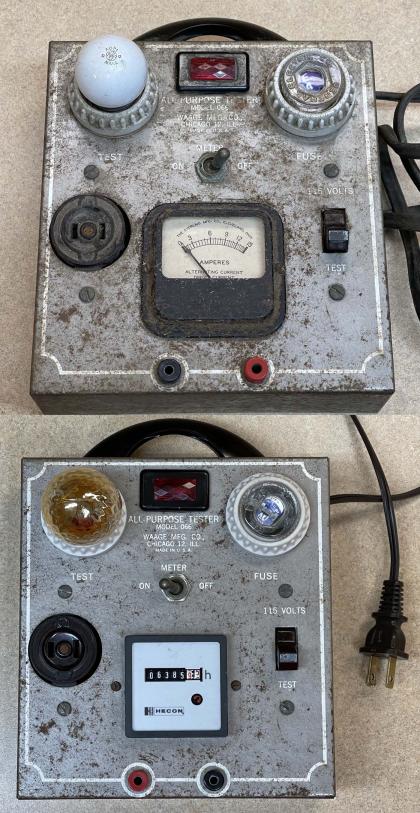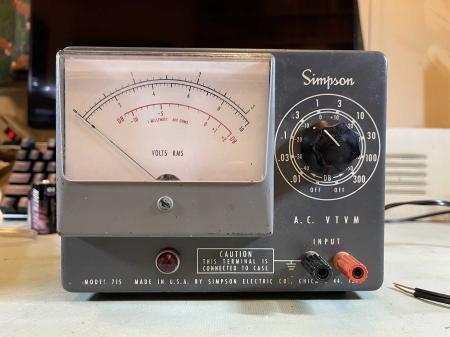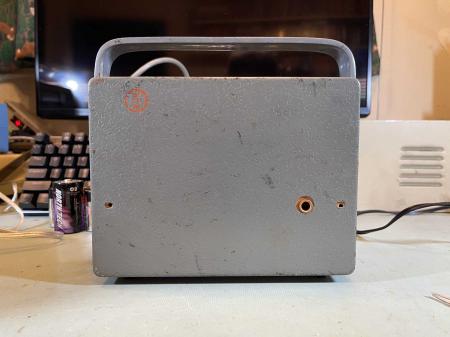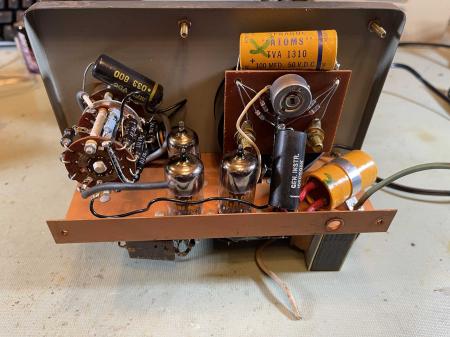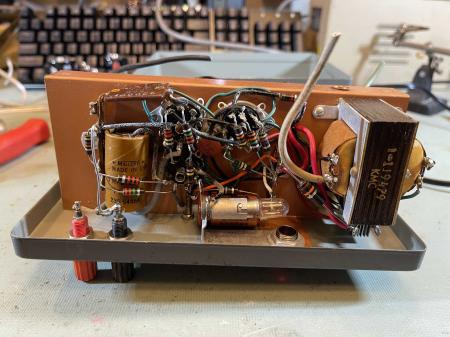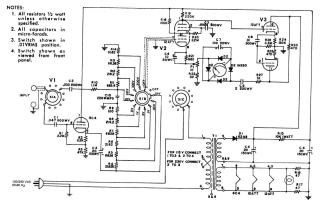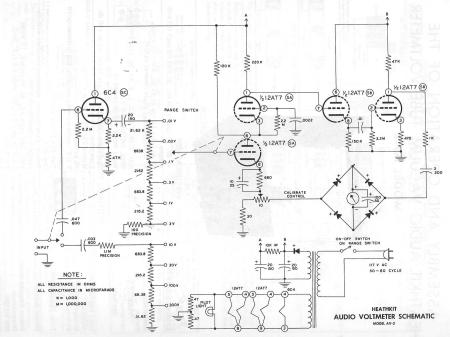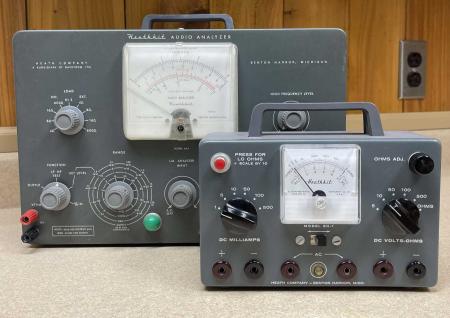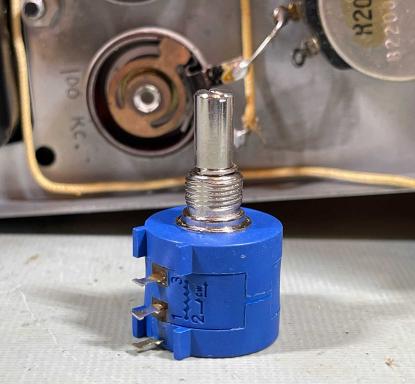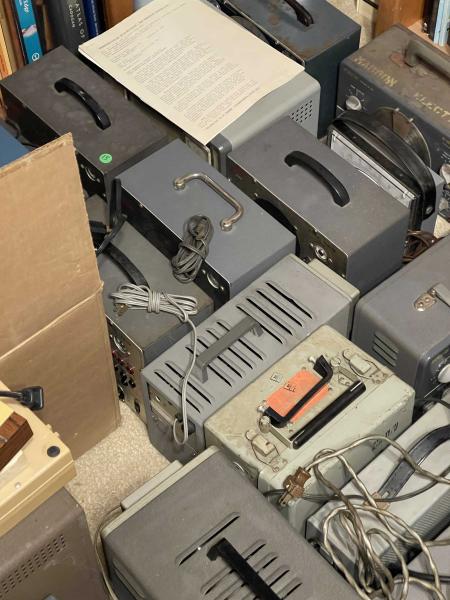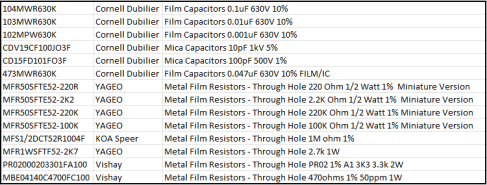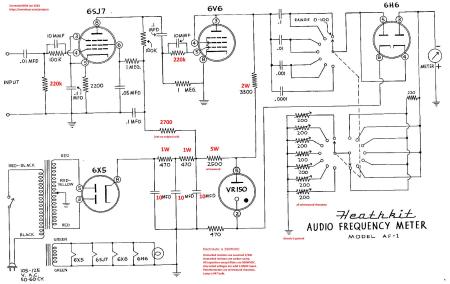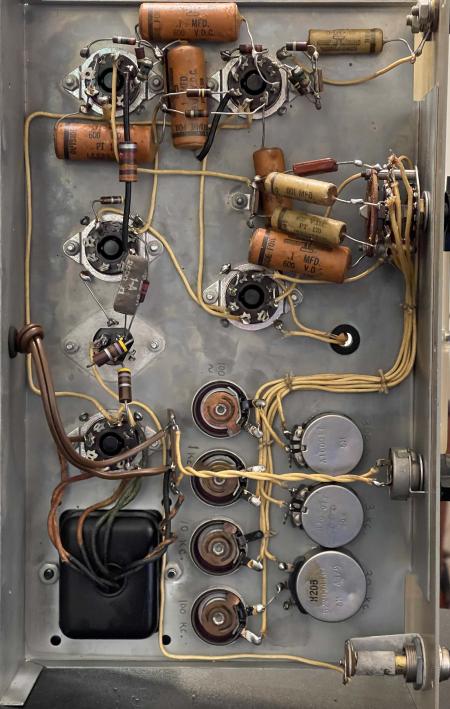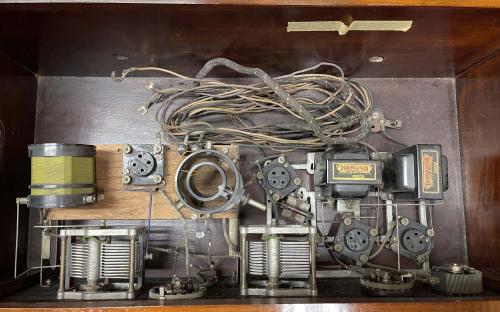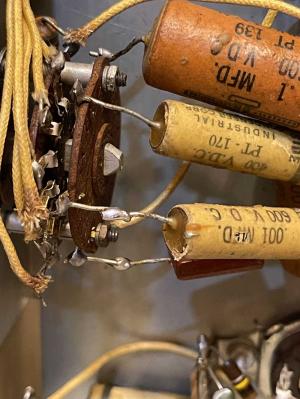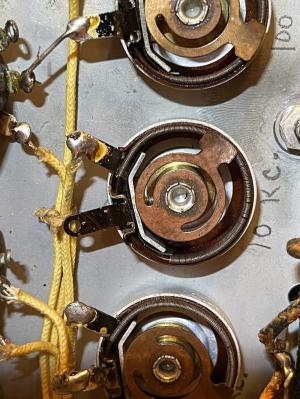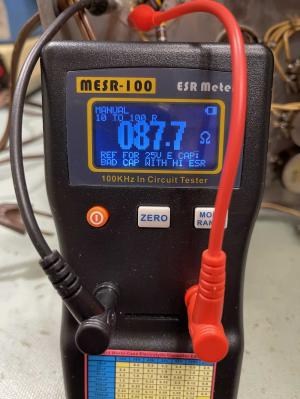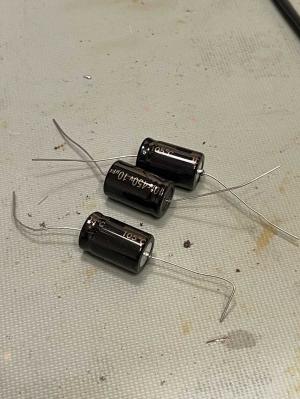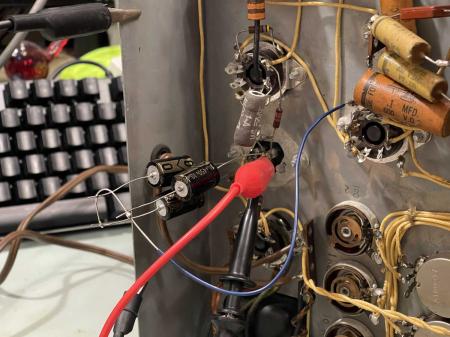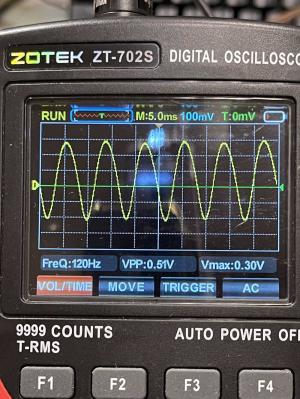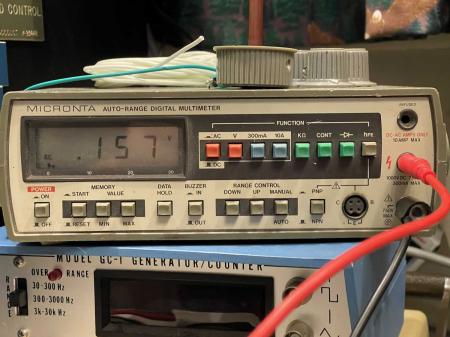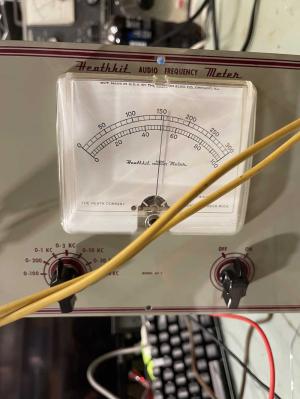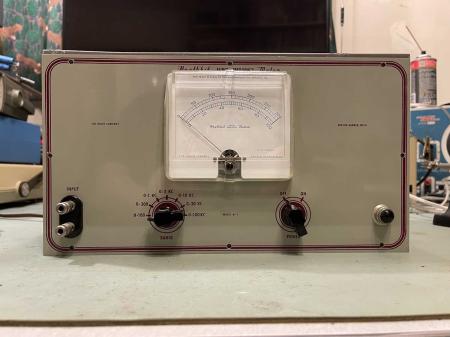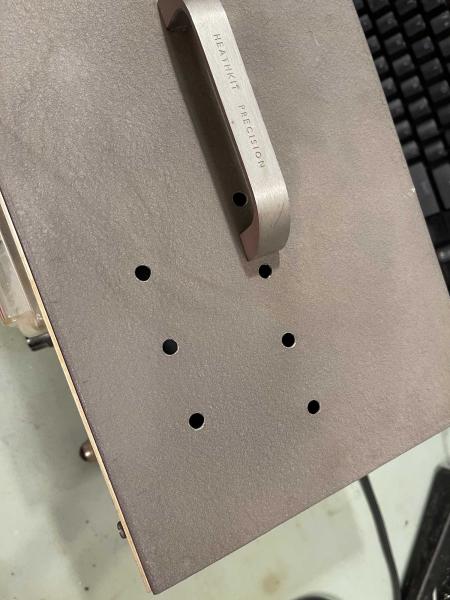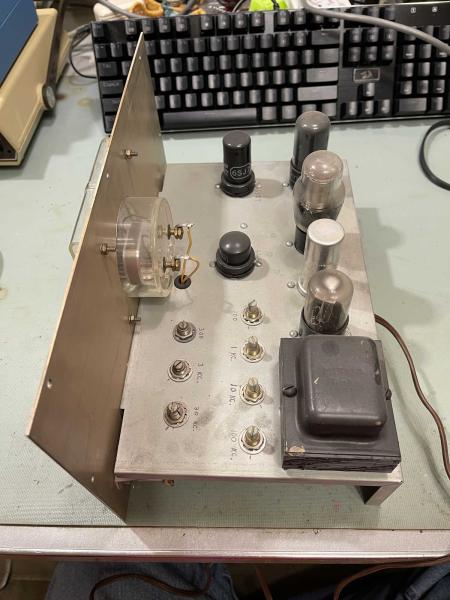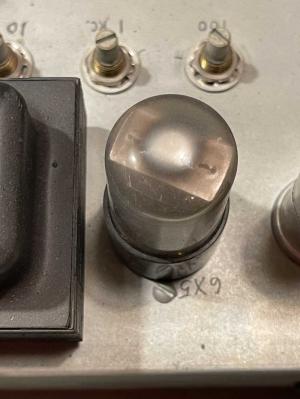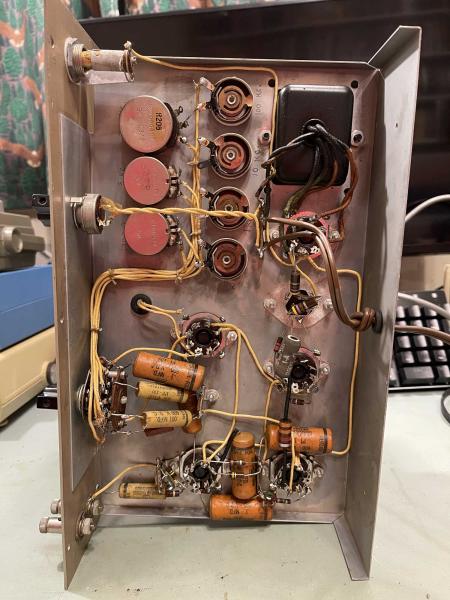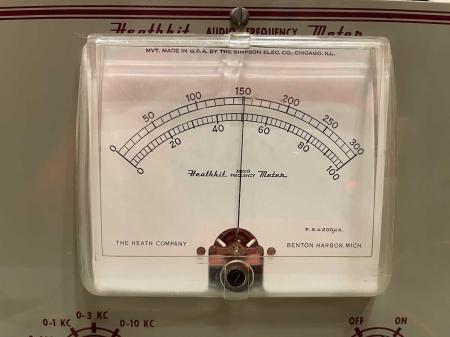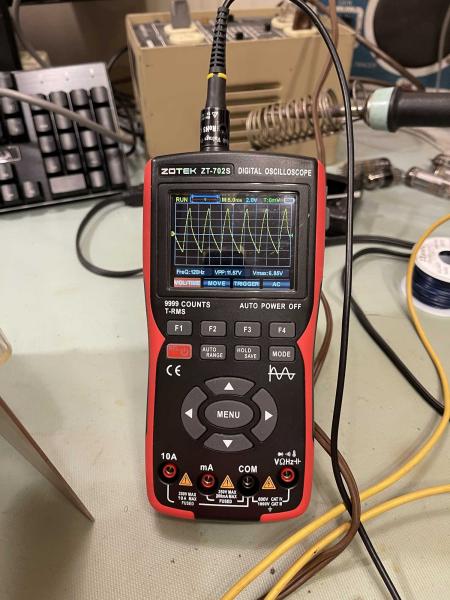- 2025
- Feb
- 9
What I did with this thing - The Waage 066 test box.
About a month ago, I made a post about what to do with this piece of not very useful technology:
https://wereboar.com … -waage-066-test-box/
Instead of discarding it, I decided to open it up, remove all of the wildly underrated wire, and make it into a display piece.
Everything was removed, cleaned and replaced save the original ammeter. A 15A meter isn’t all that useful here, and I didn’t have anything that would fit the hole except for an hour counter, so it went in there. I’m going to look for a voltmeter at shows this year, but a 2” meter isn’t as common at 2 1/8 and larger units.
The outlet, big toggle, and sockets were all cleaned in an ultrasonic bath. The little metal toggle in the middle, certainly not rated for 15A, was just surface cleaned. All parts were reinstalled into their original location. A new power cord was added None of the switches or outlets were reconnected - they’re just decoration at this point.
A bit of cleanup of the surface rust, an LED peanut bulb, and we’re back in business.
I know some said to restore it to use, but…it’s not really worth doing that. It’s now sitting in a room in the house I don’t use much, providing just enough light to see what’s in there.
- 2025
- Feb
- 4
A Simpson 715 AC VTVM
This device is an AC only VTVM with a dB scale. It’s often mentioned as a meter made for audio use. It’s a compact, good looking unit.
The front is mostly taken up by the meter face:
The back has nothing except the screw holes and a metal grommet hole for the cord.
When I received this meter, it had a rubberized 3-prong grounded plug on it. I’ve seen pictures of others with 2-prong, but the schematic seems to indicate the chassis was grounded. I’ve got a two-prong on it for testing, but will replace with the proper cord later.
The inside of the unit is pretty busy.
Tube compliment is:
12AT7
12AT7
6C4
Power is provided by a selenium rectifier for the transformer. It’s a pretty simple device, an input amplifier to provide the high impedance, a cascode amplifier to drive things, and the signal voltage is rectified right on the meter. Nothing too fancy here.
However, like many things from this time period, it doesn’t work right. That’s probably due to the capacitors leaking, or perhaps something else has gone wrong over the years. The Simpson manual provides a schematic, but no real troubleshooting information.
What would be helpful here is voltage information for the tubes and some “Does it do this?” information.
Enter the Heathkit AV-3.
There’s no picture, you can find plenty of them all over the internet. However, what’s odd about this unit is that some of them have “Simpson Elec Co” on the meter face. Why is that? Well, here’s the schematic for the AV-3:
You’ll notice, other than parts placement on the schematic, that it’s the same thing. Heathkit must have contracted Simpson to assemble these for people who wanted to purchase an assembled unit. Since this was also sold as a kit, that means one of Heathkit’s lovely manuals must exist for the unit. BAMA and other souces didn’t have it, so I sourced one from ManualMan, and there it is:
This thing may have a chance at living again. Stay tuned!
- 2025
- Jan
- 31
The Heathkit EK-1 multimeter.
Here’s a picture of the EK-1 next to it’s big brother, the AA-1:
Isn’t that adorable? It’s so small.
The EK-1 was a piece of equipment you build as a teaching aid for an electronics course of the same name. It’s interesting in that it’s a voltmeter/ammeter with no battery requirements - although the ohms function does require a single C-cell. The Ω/V rating is pretty low, since it’s really nothing more than a meter with some resistors in it - no active components here! The only AC function is a neon lamp to check 110VAC, so this is a glorified appliance test box.
Still, it’s cool in that it looks like a piece of Heathkit equipment, there’s no batteries needed for the most part, and it can sit there on the bench ready to go as a power supply test unit, or a tester for anything else where a bit of load won’t bother it.
It’s going to go on the bench as soon as I give it a contact cleaning and a new battery. (The AA-1 is also in queue.) You’ll probably see it in some shots in the future, stay tuned!
- 2025
- Jan
- 28
The Heatkit AF-1 Analog Frequency Meter, Intermission.
One of the things I’ve been considering with the Heathkit AF-1 I have on the bench right now is the potentiometers. The originals were 200Ω wirewound rheostats, but the original owner of the device replaced some with 5kΩ carbons. No idea why.
Future me note: I’m not sure what went on at Heathkit, but this device went through some revisions before being released to the general public. Perhaps it was released before full testing had finished, but it appears that even when new the device didn’t quite perform correctly with the included parts. The original owner attempted to correct these failings, but needed a bit more dial-out range in some spots. The good quality, stable parts we have available today certainly help here as well!
New parts will bring increase the precision of the device (as much as you can with an analog meter of this type!) so I’m torn. Leave the old parts in place and assume the original builder knew what he was doing, or get new 200Ω devices.
I didn’t leave the old parts there. New 10-turn wirewound potentiometers made this thing easy to dial in.
The blue pot in the foreground is a 10-turn, 2W, 200Ω device. These are relatively cheap (~$2) if you buy them direct, so I picked up a couple. One 200Ω, one 5kΩ. I’m planning on restoring the power supply on this device first, so I’ll put one in circuit and see how it does.
Of course, the only problem is they are the finest chinesium. They say Bourns on the bottom, and they probably were based upon that device. Will they hold up? I don’t plan on using this device a whole bunch, but stay tuned and we’ll find out!
Next part of this series: https://wereboar.com … -different-approach/
Previous part of this series: https://wereboar.com … -meter-part-4-parts/
- 2025
- Jan
- 22
What do you mean I have a problem?
I don’t have a problem.
Well, maybe I do have a little bit of a problem. But they all work. They’re just waiting…for…something. Yes, that’s it.
- 2025
- Jan
- 16
The Heatkit AF-1 Analog Frequency Meter, Part 4 - Parts.
After going through and correcting the schematic, I now have a list of parts to order. The only one I don’t need is the 2.5K resistor that feeds the plate of the voltage regulator tube - I already have a small supply of 5W qualified parts, and will use one of those instead of buying more.
Other than that, this is my list:
All of these are exact values, except for the 0.05μF - 0.047μF is close enough here, and probably is closer to the original value part due to lower tolerances.
If you’d like to purchase these for yourself, the text of the part numbers:
104MWR630K
103MWR630K
102MPW630K
CDV19CF100JO3F
CD15FD101FO3F
473MWR630K
MFR50SFTE52-220R
MFR50SFTE52-2K2
MFR50SFTE52-220K
MFR50SFTE52-100K
MFS1/2DCT52R1004F
MFR1WSFTF52-2K7
PR02000203301FA100
MBE04140C4700FC100
For most of these items, I’m purchasing at the price break simply because these are common values and I can use them elsewhere. Resistors are probably overkill here at 1%, but they’re cheap - some of the half-watt units are under $2.00 for 100 pieces. A couple of the parts, like the 470Ω resistors, I’m buying multiples of the highest wattage used in the unit, again - for the price break. A 1W part in a 1/2W spot is meaningless with a point-to-point chassis as open as this one.
The only ones I’m keeping to quantities needed are the more expensive items - the 10pF and 100pF mica units are rather expensive, so I get what I need. Your purchases depend on your needs, however.
I’m going to go over the list one more time, then place an order.
Some may think that this isn’t really a good use of money or time due to the fact the device is quite obsolete, but that isn’t the value of the exercise. I like this unit, it’s a cool piece, and it’s going to go on my bench once completed.
Stay tuned for parts!
Next part of this series: https://wereboar.com … -meter-intermission/
Previous part of this series: https://wereboar.com … hematic-corrections/
- 2025
- Jan
- 14
The Heatkit AF-1 Analog Frequency Meter, Part 3 - Schematic Corrections.
I didn’t have (and couldn’t find) a manual online for this device, but ManualMan had a reproduction manual available. This was my first time ordering one of these, and I can highly recommend this service. The manual is a comb-bound booklet with cardstock covers and a large, fold out schematic. If you want something that resembles the original, this is your stop.
You can check them out at https://www.manualman.com/.
I procured that because my unit and the schematic I found online differ, and some things I’ve seen elsewhere suggest that the online version is a pre-production schematic taken from the Heathkit schematics book. The schematic in the manual has resistor wattages, capacitor voltages, and a component that doesn’t exist on the pre-prod version. I’m not going to copy the manual that I purchased (but will copy a version that I find in the wild, if one exists) here, but I’ve made corrections to the schematic that’s online.
My corrections are in red, but the compression on the image may make it difficult to read. Click this for a larger version suitable for 11×17 printing.
Future me note: This is not the final schematic. You can find that in the wrapup post, or at this link.
Next is to make some decisions about parts. I’ll probably keep capacitors at their specified voltage (or higher) even though nothing more than 400V should be present. Resistors will keep their wattages, or in the case where multiple wattages of the same resistance exist, I’ll just use the higher wattage for everything so as to buy components in bulk.
Stay tuned for the parts list in part 4.
Next part of this series: https://wereboar.com … -meter-part-4-parts/
Previous part of this series: https://wereboar.com … eter-part-2-testing/
- 2025
- Jan
- 9
An Unknown 2-dial TRF radio part 2: Identifying things inside.
Back in November, I made a post about a homebrew coffin TRF radio that I picked up for a song at the Scott Antique Market in Columbus. I’ve been digging into this unit some and have identified it as a single RF amp stage TRF.
This helps solve the location of the tubes, from left to right:
UX201A RF Amp
UX200A Gaseous Detector
UX201A Audio Amp
UX201A Audio Amp
I’ll need 90V for the plates of the UX201A, and 22.5 for the plate of the UX200A detector - these apparently can’t be run much past 30V, otherwise they act like a neon lamp and ionize. I’ll also need something for the filaments - the UX2xx all run on 5V, but all the original operator would have had was a 6V dry cell and a rheostat. 5V is really easy for us to get these days, so I’ll probably just yank a linear supply from something and set that up. The other two supplies may require some doing, but I can do this easily enough with linear regulators as well, just lift them above ground.
So…next step is to actually sit down and identify the battery wires based on where they go, which should be easy enough now that I know what they should be connected to!
Next part of this series: https://wereboar.com … s-inside-identified/
Previous part of this series: https://wereboar.com … wn-2-dial-trf-radio/
- 2025
- Jan
- 2
The Heatkit AF-1 Analog Frequency Meter, Part 2 - Testing.
In the last part, we checked out the Heathkit AF-1 Frequency Meter and found that, at minimum, the power supply filter was bad.
This isn’t necessarily a virgin unit, as evidenced by the different styles of potentiometer in the thing. There’s other evidence, including things like these j-hooked capacitors on the range switch.
The original rheostats are kind of unique here. You can see that there’s one lead left unhooked on this device:
That threw me for a minute, but a quick probe revealed that one side is tied directly to ground. But we’re not here to look at the design choices of yesterday, we need to see what’s bad now. Probing the filter capacitors with an ESR meter revealed that they’re either high ESR, or completely open and I’m just getting pure resistance from somewhere else in the circuit:
They’re not shorted, so we can just parallel some parts across it. I have some random 10μF caps laying around, and at 450VDC they’re more than enough for this device. As an aside, the schematic I have specifies 20μF, but that appears to have been a pre-print schematic. I have a manual ordered since I wasn’t able to find one online, so we’ll see what that says.
Installing them was just tacking them in and running a ground:
That calmed the ripple down a lot.
Still is way off in measurement, however.
It’s still giving me the same reading as before. While I was able to dial it in somewhat, it’s not accurate. Well, it’s not as accurate as it should be, so all of the capacitors and probably resistors should be replaced.
There’s no assembly instructions for this device, as it was sold as an “advanced kit.” No big deal, it’s simple enough to build from the schematic. Off to Mouser for parts!
Next part of this series: https://wereboar.com … hematic-corrections/
Previous part of this series: https://wereboar.com … quency-meter-part-1/
- 2025
- Jan
- 2
The Heatkit AF-1 Analog Frequency Meter, Part 1.
Here’s a relatively unusual piece of equipment up next on the bench, an analog frequency meter (not counter!) made by Heathkit - the Model AF-1. This is similar to pieces made by HP before they moved to digital displays in the 60s, and this was completely obsolete by the time the 1970s rolled around. This one appears to be one of the older models, using the red and beige face along with chicken-head knobs. It’s in ok shape for the age.
It’s not really a counter, per se, because it doesn’t count. If I understand the theory correctly, it works akin to a light dimmer model. In a light dimmer, you cut part of the sinewave off - the more sinewave remaining, the brighter the lamp. With this unit, it shapes the incoming signal down to a spiked pulse - the more pulses, the higher the average voltage presented to the meter, and the more deflection you get. It’s as accurate as the meter makes it, and is basically a frequency to voltage converter. It uses 7 ranges, individually adjustable, and covers 0-100kHz. Front panel is sparse, with input, range, power, pilot, and meters.
This is kind of an oddball piece of equipment. It was made from 1951 to 1959, and by the time digital technologies rolled around in the 60s, this piece of equipment was obsolete - it’s trivially easy to count frequency with digital devices, so these probably went in the bin. Other devices - voltmeters, signal generators, even scopes are still useful today and can provide viable data, but this is just a relic of yesterday.
When I received the unit, it had 7 holes drilled into the top. I wasn’t sure why, but found out later when I opened it.
Inside, we see the tubes, transformer, and 7 calibration pots. That’s what the holes are for.
Tube compliment:
6X5 rectifier for a full wave power supply.
VR150 / OD3 150V voltage regulator to provide a stable voltage to the measurement circuit
6SJ7 as an amplifier and pulse shaper
6V6 as an amplifier and pulse shaper
6H6 as a rectifier for the incoming signal
Since this device needs to convert to a known voltage in order to do it’s work, it has a relatively unusual VR150 tube for the supplies. This tube glows a lovely purple when energized, and operates in a manner similar to a neon bulb.
This set of tubes has some hours on it, as evidenced by the tungsten burn-off on the rectifier:
The bottom is what you’d expect for a device of this era:
Nothing unusual here. The random array of drifted resistors and bad wax paper firecrackers adorns it. Of note are the adjustment pots - someone has replaced a handful of the 200Ω rheostats with 5k potentiometers. They’re of varying styles, so this was a junk bin build (or rebuild.)
I did some checks on the unit and didn’t see anything shorted, so into the isolation transformer it goes. It comes up ok, but is wildly out of cal - here it is measuring the 984Hz output from my IG72 signal generator:
In addition to being out of cal, it probably has leaky and dead capacitors everywhere. The ripple on the power supply certainly shows the filters are bad:
Yes, that’s 11.6Vp/p of ripple.
However, it’s operational. That’s what I’m here for. Next is to put some filters on it and see what happens.
Next part of this series: https://wereboar.com … eter-part-2-testing/
